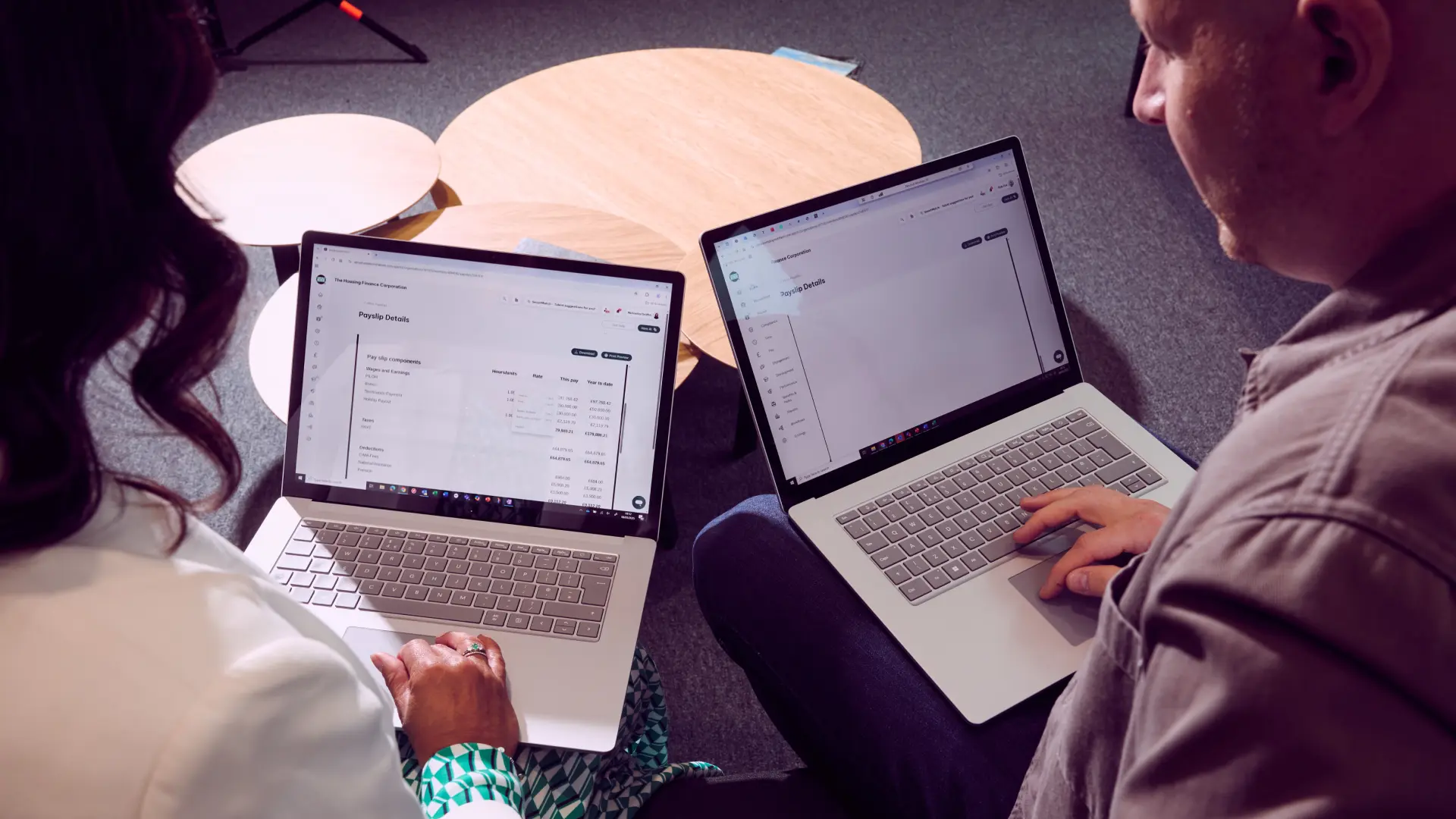ERP and HRIS: What’s the difference?
Running a growing business? Getting your tech stack nailed is non-negotiable. You’ve probably heard the buzzwords Enterprise Resource Planning (ERP) and Human Resource Information System (HRIS). Though they share similarities, they’re built for entirely different missions. Let’s cut through the noise and break down exactly what you need to know.
-

Rachel Smith

Contents
What is an ERP system?
ERP stands for Enterprise Resource Planning. It’s a central platform that connects core business functions so different departments can share data, streamline workflows and improve decision-making.
Think of ERP as the digital backbone of an organisation. It brings finance, operations, supply chain, procurement, inventory and even HR into one unified system. Instead of each department working in isolation, ERP allows everyone to work from the same source of truth.
The goal? Increased efficiency, reduced duplication and better visibility across the business.
Typical ERP modules and examples
ERP systems are modular. Businesses choose the modules they need based on their size, industry and goals. Common ERP modules include:
- Financial management and accounting.
- Supply chain and inventory control.
- Procurement and purchasing.
- Customer relationship management (CRM).
- Human resources and payroll.
- Project management.
- Manufacturing and logistics.
Some of the best-known ERP providers include SAP, Oracle, NetSuite and Microsoft Dynamics.
What is an HRIS system?
HRIS stands for Human Resource Information System. Unlike ERP, which spans the whole business, HRIS focuses entirely on the people side of operations. It’s software built specifically to support HR teams.
HRIS platforms manage employee data, automate HR tasks and help businesses stay compliant. Depending on the setup, you might find a HRIS integrated into a larger ERP system, or operating independently as a best-of-breed solution.
Where ERP handles the engine room of the business, HRIS takes care of your people.
Common HRIS features
HRIS platforms come packed with features designed to support the employee lifecycle. These often include:
- Employee records and document management.
- Payroll processing and pay slip generation.
- Benefits and leave management.
- Onboarding and offboarding workflows.
- Compliance tracking and reporting.
- Performance reviews and development plans.
- Employee self-service portals.
- HR analytics and reporting.
Popular HRIS providers include BambooHR, Zoho People, Gusto and Employment Hero’s own HR software.
ERP vs HRIS: Key differences explained
Let’s break down the most important differences between ERP and HRIS.
|
Feature |
ERP |
HRIS |
|---|---|---|
|
Scope |
Company-wide (finance, supply chain, HR and more) |
HR-specific |
|
Complexity |
High – supports multiple functions |
Lower – focused on HR |
|
Implementation |
Time-consuming and resource-heavy |
Faster and more flexible |
|
Cost |
Higher initial and ongoing costs |
Lower cost and quicker ROI |
|
Best for |
Large businesses with cross-functional needs |
SMEs or HR-led initiatives |
Whether you’re searching ‘ERP vs HRIS’ or wondering about the difference between HRIS and ERP, the answer comes down to scope and strategy.
When HRIS is the better fit
A HRIS is often the ideal choice for businesses that are growing fast but not yet at enterprise scale. If your main challenges sit within your HR team, like manual admin, patchy compliance processes or inconsistent onboarding, a HRIS can deliver fast, measurable results.
You should consider a HRIS if:
- You’re a small or medium-sized business: HRIS platforms are built to be lightweight, affordable and easy to use. They don’t require a massive IT team or large-scale infrastructure to implement, making them perfect for SMEs.
- Your priority is digitising HR processes: If your HR team is still reliant on spreadsheets, email chains and paper forms, a HRIS can automate routine tasks, reduce errors and free up time for more strategic work. From onboarding to leave management, everything becomes easier to track and manage.
- HR owns the transformation agenda: In many organisations, it’s the HR team, not the IT department – leading the charge on modernisation. A cloud-based HRIS lets HR leaders roll out improvements without waiting for lengthy procurement cycles or technical roadblocks.
- You want a quicker rollout with less IT involvement: Most HRIS systems are cloud-based and designed for rapid deployment. They offer intuitive interfaces, templated workflows and low training overheads, which means you can start seeing value in weeks rather than months.
For people-first businesses that want to modernise HR quickly and cost-effectively, a HRIS delivers both operational efficiency and employee experience improvements.
When ERP makes more sense
ERP systems are powerful, enterprise-grade platforms designed to manage complexity. If your business operates across multiple departments, geographies or entities, an ERP can bring structure, control and insight to your operations.
ERP may be the right fit if:
- You need to integrate multiple departments: If your finance, procurement, warehousing, sales and HR teams all rely on different tools, data can become siloed. ERP brings these functions together, allowing seamless information sharing and real-time reporting.
- You’re scaling quickly across regions or product lines: Fast-growing businesses often outgrow basic systems. ERP systems provide the scalability and customisation needed to support expansion across countries, currencies and compliance regimes.
- You want one central platform for all data: ERP systems create a single source of truth across your organisation. This helps eliminate duplicate records, improves data accuracy and supports better forecasting, reporting and strategic planning.
- You have a CIO or CTO driving digital transformation: ERP implementations are typically led by IT leaders and involve significant technical input. If your business has a dedicated digital strategy and the resources to support a large-scale rollout, an ERP can drive long-term transformation.
ERP is built for businesses with complex operations, cross-functional goals and the resources to invest in enterprise-wide systems. It’s a powerful tool, but it’s not always the fastest or most cost-effective option for HR-led initiatives.
Is HRIS part of ERP? Understanding the overlap
HRIS and ERP systems often exist side by side and sometimes their roles can blur. Many ERP platforms include HR functionality, such as payroll processing or employee record management. These modules are usually built into the broader system, allowing organisations to manage HR data alongside finance, inventory and other functions. On the surface, this sounds efficient, but it’s important to look deeper.
While ERP systems may include HR modules, these are often limited in scope. They typically cover only the basics and may lack the flexibility, depth and user-friendliness of a dedicated HRIS. For example, features like onboarding workflows, employee engagement tools, performance reviews and self-service portals are usually more robust in a stand-alone HRIS.
Whether to use an ERP’s built-in HR module or opt for a separate HRIS depends on several factors. Businesses with simple HR needs and a strong existing ERP setup may find that the built-in functionality is enough. However, for organisations with more advanced people strategies or a focus on employee experience, a specialised HRIS will be better equipped to support those goals.
Many businesses choose to integrate both. A dedicated HRIS can sync data with the ERP, offering the depth of HR features without losing visibility across departments. The success of this approach depends on scalability, integration options and how central HR is to the business strategy.
Ultimately, ERP and HRIS systems can complement each other. The key is understanding your needs and choosing systems that will work together as your business evolves.
Choosing between ERP and HRIS for your business
Deciding between an ERP and a HRIS starts with understanding what your business really needs. Each system has strengths, but the best fit depends on your goals, size, resources and timeline. Use this checklist to guide your decision.
1. Business size
Are you a small or medium-sized business looking for a straightforward solution, or a larger organisation needing full-system integration?
- If you’re an SMB with limited IT resources, a HRIS is usually faster to deploy and easier to manage.
- If you’re operating across departments, regions or legal entities, an ERP may offer the scalability and oversight you need.
2. Your business goals
What problem are you trying to solve?
- If your main goal is to streamline HR processes like payroll, onboarding or compliance, a HRIS will deliver focused, people-first automation.
- If you want one platform to manage finance, procurement, supply chain and people operations, ERP offers a single source of truth across your organisation.
3. IT capacity and ownership
Who will lead the implementation?
- HRIS platforms are often owned and managed by HR, with minimal need for technical support.
- ERP systems usually require IT leadership and can involve extensive configuration, data migration and ongoing maintenance.
4. Budget and ROI expectations
What are you willing and able to invest?
- HRIS platforms are typically more cost-effective, with flexible pricing and shorter time to value.
- ERP solutions are a longer-term investment, with higher upfront costs and a longer implementation cycle.
5. Implementation timeframe
How quickly do you need results?
- If you need an HR solution up and running in weeks, a HRIS is the faster option.
- If you’re planning a company-wide transformation and can wait several months, ERP may be a better strategic fit.
Choosing the right system isn’t just about software; it’s about empowering your business to thrive. A HRIS can immediately transform your HR team, freeing them to build a workforce that drives your success. An ERP, on the other hand, can orchestrate a full-scale transformation, bringing control and insight across your entire operation. Both are powerful tools, ready to elevate you, the employer, when applied in the right context.
Employment Hero – Your complete HR system, all in one place
At Employment Hero, we’ve built a powerful, all-in-one HRIS designed to help businesses streamline people management, stay compliant and create better employee experiences. Whether you’re managing five employees or five hundred, our platform gives you the tools to automate admin, reduce manual processes and focus on what really matters. Your people.
From onboarding and performance to payroll and compliance, Employment Hero brings everything HR into one simple, cloud-based system. No complex IT rollout. No messy integrations. Just smart, scalable software that grows with your business.
Ready to modernise your HR?
Book a demo and see how Employment Hero can transform the way you work.
FAQs about ERP and HRIS
The main difference is in scope. ERP systems manage multiple business functions – including finance, operations, inventory and HR – in one central platform. HRIS systems focus specifically on managing people operations. If your priority is automating and improving HR processes like payroll, onboarding or compliance, a HRIS is often the better fit.
Yes. Many HRIS platforms offer integrations with leading ERP systems, allowing you to sync employee data across platforms without duplicating effort. This setup gives businesses the best of both worlds; specialist HR tools with full visibility across other departments. The key is choosing a HRIS that supports open APIs and can scale alongside your tech stack.
Sometimes. Some ERP platforms include HR modules, offering basic functionality for managing employee records, payroll and benefits. However, these tools are often limited compared to a dedicated HRIS. If HR plays a strategic role in your business, or you need more advanced features like performance reviews or employee engagement tools, a stand-alone HRIS will deliver greater value.
Absolutely. Many companies choose to use both systems together. An ERP might handle finance, supply chain and operations, while a HRIS manages people processes. When integrated properly, the two systems complement each other – giving your teams access to accurate data while allowing HR to work with tools tailored to their needs.
Most ERP systems include some form of HR functionality, such as payroll or personnel record management. However, these features are usually built to cover the basics and may not be flexible enough for businesses with more advanced HR needs. A dedicated HRIS typically offers a better user experience, more automation and deeper reporting for HR teams.
For most small businesses, a HRIS is the better choice. It’s quicker to implement, easier to manage and more cost-effective. HRIS platforms are designed with growing teams in mind, offering smart features that reduce admin and improve compliance without requiring complex infrastructure. ERP systems can be valuable at scale but may be more than a small business needs.
Related Resources
-
 Read more: Is your HR system still stuck in the Stone Age? It’s time to future-proof
Read more: Is your HR system still stuck in the Stone Age? It’s time to future-proofIs your HR system still stuck in the Stone Age? It’s time to future-proof
Manual HR processes create hidden costs and risks. Learn how a future-proof HR system can unlock efficiency, compliance, and business…
-
 Read more: Automate HR Processes: 5 Key Processes You Should be Automating in 2025
Read more: Automate HR Processes: 5 Key Processes You Should be Automating in 2025Automate HR Processes: 5 Key Processes You Should be Automating in 2025
Automating HR processes is no longer a far-off future goal, it’s a strategic necessity. We’re diving into exactly why your…
-
 Read more: AI in HR: How to keep the human in Human Resources and payroll with AI
Read more: AI in HR: How to keep the human in Human Resources and payroll with AIAI in HR: How to keep the human in Human Resources and payroll with AI
Discover how AI can complement human efforts in HR and enable teams to focus on the bigger picture.



















